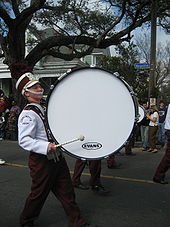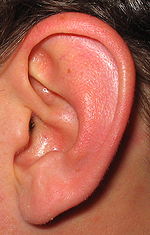Sound is a mechanical wave that is an oscillation of pressure transmitted through a solid, liquid, or gas, composed of frequencies within the range of hearing and of a level sufficiently strong to be heard, or the sensation stimulated in organs of hearing by such vibrations.

Propagation of sound
Sound is a sequence of waves of pressure which propagates through compressible media such as air or water. (Sound can propagate through solids as well, but there are additional modes of propagation). During their propagation, waves can be reflected, refracted, or attenuated by the medium.
For Humans, hearing is normally limited to frequencies between about 20 Hz and 20,000 Hz (20 kHz)[3], although these limits are not definite. The upper limit generally decreases with age. Other species have a different range of hearing. For example, dogs can perceive vibrations higher than 20 kHz. As a signal perceived by one of the major senses, sound is used by many species for detecting danger, navigation, predation, and communication. Earth's atmosphere, water, and virtually any physical phenomenon, such as fire, rain, wind, surf, or earthquake, produces (and is characterized by) its unique sounds. Many species, such as frogs, birds, marine and terrestrial mammals, have also developed special organs to produce sound. In some species, these produce song and speech. Furthermore, humans have developed culture and technology (such as music, telephone and radio) that allows them to generate, record, transmit, and broadcast sound.

Harmonic Oscillator:
A harmonic oscillator is defined as a system, which induces a restoring force F which is proportional to the displacement X, when the oscillator is said to be in its stable position. In terms of Hook’s law
F = -kx, where k is a constant that is positive.
If F is the said to be the only force on the system then the system is said to be the simple harmonic oscillator and it has the simple harmonic motion.
X(t) = A sin (2∏ft +  )
)
F = m (d2x/ dt2) = -kx.
The damped harmonic oscillator in physics represents the oscillator with slow motion. Generally damping slows down the motion of the system. The equation of the damped oscillator is given by
d2x / dt2 + 2ζω0 +ω02x = 0
Here w0 is called as the angular frequency of the oscillator that has not been damped and in physics it is given by the equation,
ω1 = ω0 √(1-ζ2)
The to and fro motion of a body about a mean position is called oscillation. When a body execute oscillations under the action of external periodic force, Those oscillations are called forced oscillations.
When one of the two bodies of same natural frequency is set into vibration, the other body also vibrates with larger amplitude under the influence of the first one. This phenomenon is called Resonance.
Take two hollow boxed A and B, open it one side. Place two boxes with their opened sides facing each other with some distance apart. Mount two tuning forks of same natural frequencies one each on the two boxes. Vibrate the tuning fork on the box A, the tuning fork on box B also begins to vibrate due to resonance. When A is vibrated, the air inside the box A vibrates and these vibrations are transferred into the box B and in turn vibrated the tuning fork on B.
Vibrate a tuning fork and place it on a table or bench, Then we can hear a loud sound which is because the table top is forced to vibrate under the influence of the vibrating tuning fork.
Suspend 4 pendulums A, B, C, D in which A and C are of same lengths, B and D are of different lengths. When Pendulum A is oscillated, the other three pendulum's also start oscillating. A and C are in Resonance with each other and the oscillations of B and D are called forced oscillations.
Examples : When solders are crossing a suspension bridge, they are asked to break their steps. This is because , when the frequency of the marching coincides with the natural frequency of the bridge, the bridge vibrates with larger amplitude and collapses due to resonance.
A radio is tuned to obtain a clear sound, such that the frequency of the radio have to coincide with the frequency of the incoming electro-magnetic waves.
When solders are crossing a suspension bridge, they are asked to break their steps. This is because , when the frequency of the marching coincides with the natural frequency of the bridge, the bridge vibrates with larger amplitude and collapses due to resonance.
A radio is tuned to obtain a clear sound, such that the frequency of the radio have to coincide with the frequency of the incoming electro-magnetic waves.
We can find the velocity of sound using resonance phenomenon with resonating air-column experiment.
“If a mechanical wave travels in a medium and the medium particles oscillate along a direction perpendicular to the direction of motion of the wave, the wave is called a transverse wave.” In other words, if wave travels in x- direction, medium particles vibrate up or down or along y- direction. For example, when one end of a horizontal string is tied to a fixed end and the other end is moved up and down, a transverse wave travel along the rope while particles of rope vibrate up and down.
There are several examples of transverse waves in everyday life.
surface water waves,Vibrations in string, electromagnetic waves, seismic S (secondary) waves, audience wave.
A transverse wave has all properties of mechanical waves.
1. Amplitude- The maximum vertical displacement of the medium particles on either side of its equilibrium position is called as the amplitude. It is denoted by ‘a’.
2. Time period- The time taken by medium particles in completing one vibration is called as the time period of wave. it is denoted by ‘T’.
3. Frequency- The number of oscillations made by a medium particles in 1 second is called as frequency of wave. It is denoted by ‘f’.
4. Phase- The phase of the wave at any instant shows the position and direction of medium particles at that instant. it is given by a angle.
5. Wavelength- The distance travelled by the mechanical wave in one complete vibration is called as wavelength of wave. It is denoted by ‘λ’.
6. Wave speed- The distance travelled by the wave in one second is called as ‘wave speed’. It is denoted by ‘v’.
There are different types of transverse waves in nature.
1. Sine wave- These waves repeat oscillations following sine equation. This wave pattern can be seen in ocean waves and light waves.
2. Square wave- this wave pattern can be seen in digital switching circuits.
3. Saw tooth wave – these waves are non –sine waves. This wave pattern resembles to the teeth on blade of saw.
4. Triangle wave- this wave pattern is triangle in shape and contains only odd harmonics.
Sound wave is a traveling wave which is an oscillation of pressure transmitted through a solid, liquid, or gas, composed of frequencies within the range of hearing. The term sound refers to the physical sensation that stimulates our ears. In constructing sound, there must be a source for a sound. The source of a sound wave is vibrating object.
A disturbance that travels (or propagates) through space and time, usually by transference of energy is known as a Wave. A wave is a disturbance by which energy is transferred.
Waves can be of two types considering the direction of the disturbance relative to the direction of propagation of the wave. A wave which causes disturbance in the direction of its propagation is known as a longitudinal wave, whereas a wave which causes disturbance perpendicular to the direction of its propagation is known as a transverse wave.
Sound waves are the one of the most important examples of longitudinal waves. Loudness and pitch are two aspects of any sound and each refers to a sensation in the consciousness of the listener. The lower the frequency, the lower is the pitch and the higher the frequency, the higher is the pitch. For an example, a bird makes a high pitch besides a lion makes a low pitch. Sensitivity of the human ear is around 20 Hz to 20 000 Hz. They can generate by musical instruments, human vocal cords and loudspeakers.
The terms like Wavelength ( λ ), Period (T), Frequency (f), Displacement (x) ,Amplitude (x0 ) are used to describe waves.
Wavelength is the distance between two adjacent points with the same pattern of oscillation. It is also the distance the wave travels before the pattern repeats itself and is measured in metres(m).
Period (T) is the time for one complete pattern of oscillation to take place at any point. It is measured in seconds(s)
Frequency is the number of oscillations per unit time at any point and is measured in hertz (Hz).
Displacement (x) is the distance any part of the wave has moved from its mean position. It can be positive or negative and is measured in metres (m).
Amplitude (x0) is the maximum displacement, i.e. the distance from a peak to the mean (rest) position. It is always positive and is measured in metres (m).
The propagation of a sound wave is due to the movement of air particles. Regions of high pressure are known as compressions and regions of low pressure are known as rarefactions.
In the diagram, the black dots represent air molecules. As the loudspeaker vibrates, it causes the surrounding air molecules to vibrate in a particular pattern represented by the waveform. This vibration of air molecules causes the listener's eardrum to vibrate in the same pattern and it results in sound.
Variations in Air Pressure for Sound Waves and Corresponding Waveform
Sound waves exist as variations of pressure in a medium like air. The energy is transferred from the source in form of longitudinal sound waves and the sound is detected by an ear or an instrument. Sound waves travel through any material medium with a speed that depends on the properties of the medium. Sound cannot travel in the absence of a medium. The speed of sound waves depends on the compressibility and the inertial property of the medium. As the waves travel, the particles in the medium vibrate to produce density and pressure changes along the direction of motion of the wave. These changes result in a series of high pressure and low pressure regions. In high pressure regions, the series is called condensations and in low pressure region, the series is called rarefactions.
Homework Assignment Help is World No 1 Online Assignment Help Company
@2010 - Copyright © All rights reserved | This is made with by Homework Assignment Help self
In case you face any problem or have any query please email us at :- info[@]homeworkassignmenthelp.com
Submit us an Assignment:
For Demo Class Click hereRead more
Our tutors start working only after the payment is made, to ensure that we are doing work only for serious clients and also our solution meets the required standard.
Getting homework help was never so easy you just need to follow following steps:
(for example: EST, Australian GMT etc)
any example or format you want the solutions to be in.
send you the price quoted by our tutor along with the time needed to solve the assignment
In case you face any problem or have any query please email us at :- info[@]homeworkassignmenthelp.com